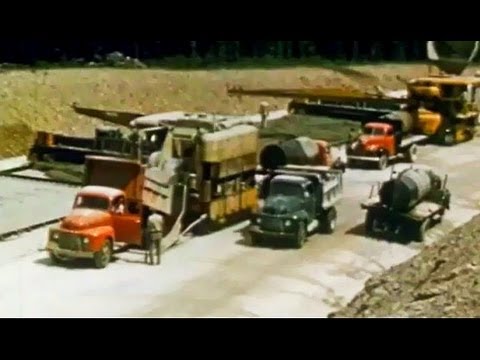more at
“Educational film about how steel is used to make highways, including problems that occur with time and use.”
NEW VERSION with improved video & sound:
Public domain film from the Library of Congress Prelinger Archive, slightly cropped to remove uneven edges, with the aspect ratio corrected, and mild video noise reduction applied.
The soundtrack was also processed with volume normalization, noise reduction, clipping reduction, and/or equalization (the resulting sound, though not perfect, is far less noisy than the original).
Reinforced concrete is a composite material in which concrete’s relatively low tensile strength and ductility are counteracted by the inclusion of reinforcement having higher tensile strength and/or ductility. The reinforcement is usually, though not necessarily, steel reinforcing bars (rebar) and is usually embedded passively in the concrete before it sets. Reinforcing schemes are generally designed to resist tensile stresses in particular regions of the concrete that might cause unacceptable cracking and/or structural failure. Modern reinforced concrete can contain varied reinforcing materials made of steel, polymers or alternate composite material in conjuction with rebar or not. Reinforced concrete may also be permanently stressed (in compression), so as to improve the behaviour of the final structure under working loads. In the United States, the most common methods of doing this are known as pre-tensioning and post-tensioning.
For a strong, ductile and durable construction the reinforcement needs to have the following properties at least:
– High relative strength
– High toleration of tensile strain
– Good bond to the concrete, irrespective of pH, moisture, and similar factors
– Thermal compatibility, not causing unacceptable stresses in response to changing temperatures.
– Durability in the concrete environment, irrespective of corrosion or sustained stress for example…
Historical road construction
The assertion that the first pathways were the trails made by animals has not been universally accepted, since in many cases animals do not follow constant paths. Others believe that some roads originated from following animal trails. The Icknield Way is given as an example of this type of road origination, where man and animal both selected the same natural line. By about 10,000 BC, rough pathways were used by human travelers.
– The world’s oldest known paved road was laid in Egypt some time between 2600 and 2200 BC.
– Stone-paved streets are found in the city of Ur in the Middle East dating back to 4000 BC.
– Corduroy roads (log roads) are found dating to 4000 BC in Glastonbury, England.
– The timber trackway; Sweet Track causeway in England, is one of the oldest engineered roads discovered and the oldest timber trackway discovered in Northern Europe. Built in winter 3807 BC or spring 3806 BC, tree-ring dating (Dendrochronology) enabled very precise dating. It has been claimed to be the oldest road in the world.
– Brick-paved streets were used in India as early as 3000 BC .
– In 500 BC, Darius I the Great started an extensive road system for Persia (Iran), including the Royal Road, which was one of the finest highways of its time. The road remained in use after Roman times…
– From about 312 BC, the Roman Empire built straight strong stone Roman roads throughout Europe and North Africa, in support of its military campaigns. At its peak the Roman Empire was connected by 29 major roads moving out from Rome and covering 78,000 kilometers or 52,964 Roman miles of paved roads.
– In the 8th century AD, many roads were built throughout the Arab Empire. The most sophisticated roads were those in Baghdad, which were paved with tar. Tar was derived from petroleum, accessed from oil fields in the region, through the chemical process of destructive distillation.
– The Highways Act 1555 in Britain transferred responsibility for maintaining roads from government to local parishes. This resulted in a poor and variable state of roads. To remedy this, the first of the “Turnpike trusts” was established around 1706, to build good roads and collect tolls from passing vehicles. Eventually there were approximately 1,100 trusts in Britain and some 36,800 km (22,870 miles) of engineered roads. The Rebecca Riots in Carmarthenshire and Rhayader from 1839 to 1844 contributed to a Royal Commission that led to the demise of the system in 1844, which coincided with the development of the UK railway system…

